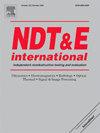混合腐蚀检测与监测方法可靠性的定量评价
IF 4.5
2区 材料科学
Q1 MATERIALS SCIENCE, CHARACTERIZATION & TESTING
引用次数: 0
摘要
传统的超声波腐蚀监测方法,如大规模c扫描和连续的局部监测,在时间分辨率或空间覆盖方面都存在固有的局限性。传感器技术和低成本自主机器人技术的最新进展使结合其优势的混合方法成为可能。然而,优化这些方法的关键问题仍然存在,包括确定最佳检查间隔、空间覆盖范围和传感器数量。本研究提出了一个多阶段框架,通过集成建模来解决这些挑战:组件表面时空演变的退化模拟,超声厚度测量的基于物理的替代模型,复制检查和监测过程的数据子采样,以及针对监视目标的可靠性评估。通过对现场测量校准的综合数据进行蒙特卡罗模拟,我们证明了混合策略的潜在优势。结果表明,传感器的策略性放置和周期性重新定位可以提高可靠性,同时降低覆盖要求和延长检测间隔。重要的是,该框架为腐蚀监测规划提供了定量指导,可以适应不同资产类型的不同退化现象。本文章由计算机程序翻译,如有差异,请以英文原文为准。
Quantitative evaluation of the reliability of hybrid corrosion inspection and monitoring approaches
Conventional ultrasonic approaches for corrosion surveillance such as large-scale C-scans and continuous localised monitoring face inherent limitations in either temporal resolution or spatial coverage. Recent advances in sensor technology and low-cost autonomous robotics enables a hybrid approach that combine their strengths. However, critical questions remain about optimising such approaches, including determining the optimal inspection intervals, spatial coverage, and number of sensors. This study presents a multi-stage framework that addresses these challenges through integrated modelling: degradation simulation for spatiotemporal evolution of component surfaces, physics-based surrogate models for ultrasonic thickness measurements, data subsampling to replicate inspection and monitoring procedures, and reliability assessments against surveillance targets. Through Monte Carlo simulations on synthesised data calibrated to field measurements, we demonstrate the potential benefits of the hybrid strategy. Results show that strategic sensor placement and periodic repositioning can enhance reliability while reducing coverage requirements and extending inspection intervals. Importantly, this framework provides quantitative guidance for corrosion surveillance planning and can be adapted to different degradation phenomena across various asset types.
求助全文
通过发布文献求助,成功后即可免费获取论文全文。
去求助
来源期刊

Ndt & E International
工程技术-材料科学:表征与测试
CiteScore
7.20
自引率
9.50%
发文量
121
审稿时长
55 days
期刊介绍:
NDT&E international publishes peer-reviewed results of original research and development in all categories of the fields of nondestructive testing and evaluation including ultrasonics, electromagnetics, radiography, optical and thermal methods. In addition to traditional NDE topics, the emerging technology area of inspection of civil structures and materials is also emphasized. The journal publishes original papers on research and development of new inspection techniques and methods, as well as on novel and innovative applications of established methods. Papers on NDE sensors and their applications both for inspection and process control, as well as papers describing novel NDE systems for structural health monitoring and their performance in industrial settings are also considered. Other regular features include international news, new equipment and a calendar of forthcoming worldwide meetings. This journal is listed in Current Contents.
 求助内容:
求助内容: 应助结果提醒方式:
应助结果提醒方式:


